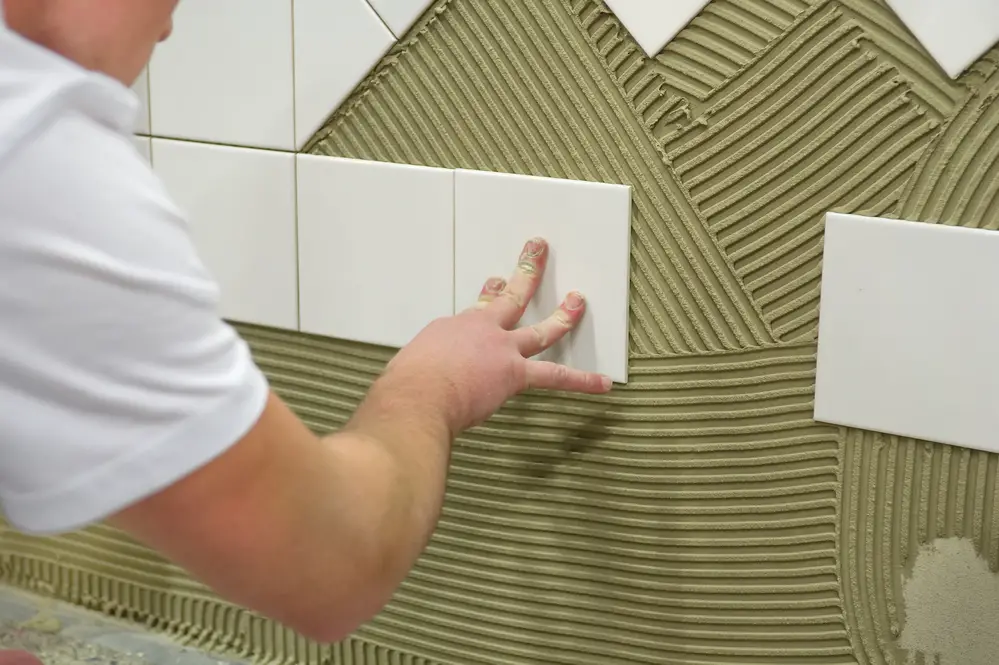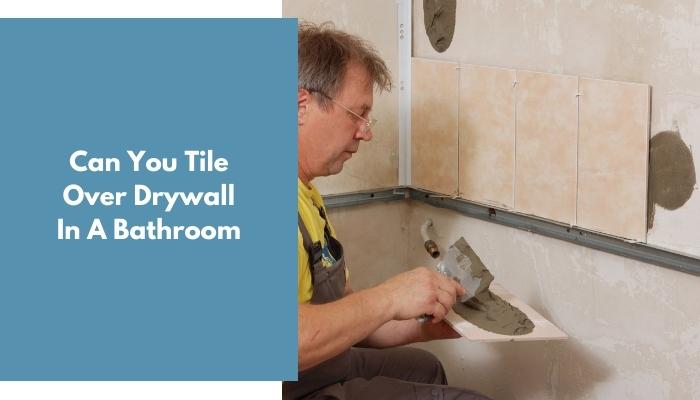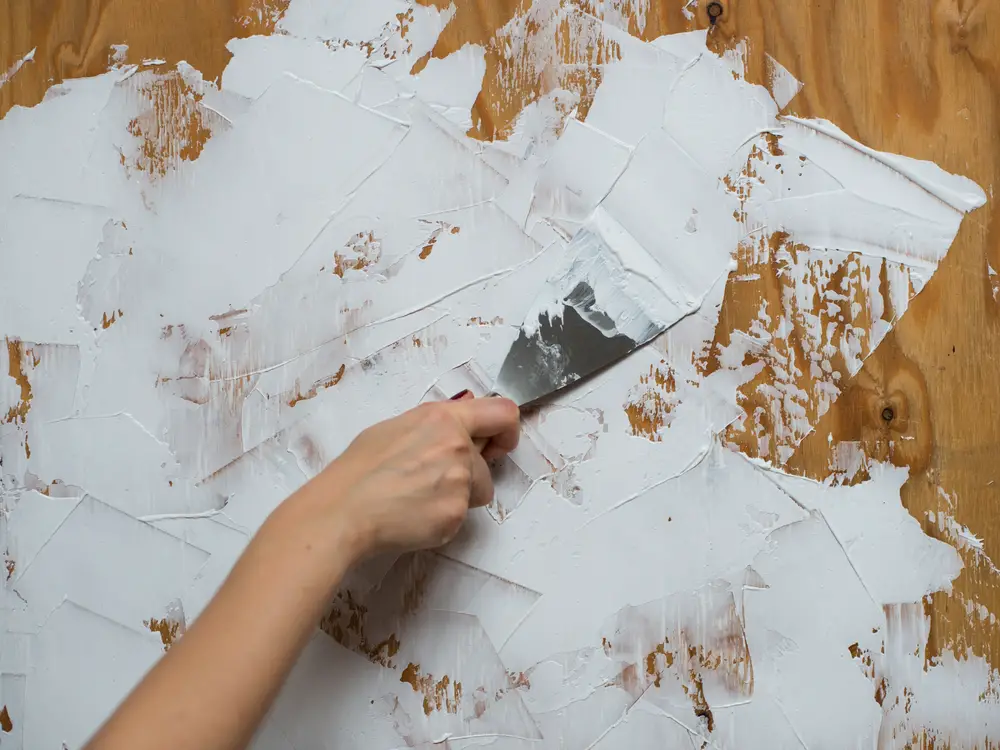While it’s not usually recommended that you tile over drywall in a bathroom, there are a few rules that you can follow to make sure that your tiling over drywall project turns out exactly how you want it to! In this article, we’ll cover everything that you need to know about tile installation over drywall.
Contents
Why It’s Not Recommended To Put Tiles Over Drywall
Most of the time, people recommend not putting tile over drywall in a bathroom because drywall can absorb moisture. Over time, it can grow mold or swell. As the drywall begins to deteriorate, it can affect your tiles. You may notice one or two tiles slowly falling off one at a time.
However, it’s important to remember that people recommending that you not do something doesn’t mean that you can’t make it happen. The following tips and ideas will help you make your DIY tiling project a success anyway.
Planning Tile Layout
Before yous tart tiling over drywall, it’s important to plan your tiling project. Tiling over drywall in certain areas is not going to be a good idea.
For example, if you would like to tile over drywall in a shower, you’ll need to take extra precautions because tile can be ruined in a humid atmosphere. Planning your project, and carefully researching how to tile over drywall, can help your DIY tiling project run smoothly.
Check The Condition Of The Drywall
It’s important that you double-check your drywall before attempting to tile over it. It needs to be completely dry with no moisture on it. A single bead of water can ruin part of your DIY tiling project.
Use Cement Board In Wet Areas
Although it’s not recommended to put tile in wet areas, there are a few things that you can do to help your tiles last longer if you choose to put them in wet areas anyway. The most important thing to do is to use a cement board in place of drywall.
The cement board does not mold and mildew like drywall does, so you can trust that it will be okay if it is exposed to a small amount of moisture.
How To Put Tile Over Drywall
If you do have an area in your bathroom that is not wet, it’s a perfectly safe idea to put tile over drywall. Follow these steps to make sure that your project is a success.
Remove Everything From The Wall
Make sure to remove any pictures, screws, etc. from the wall. It’s important that the wall is free of everything so that you can prepare the wall to lay your tile.
Prepare The Drywall
Next, you need to prepare your drywall. You don’t want to use an uneven surface for tiling. To do this, wipe the drywall clean. Give it ample time to dry. Then, repair holes and chips in the drywall. Simply fill the holes with spackling.
Finally, sand down any areas of the drywall that are raised to avoid having an uneven surface. You should have a smooth, flat wall when you are finished preparing the drywall.
Determine Whether You Need To Waterproof The Drywall
You can put tile on drywall if it is in a low moisture area. For example, if you have a large bathroom or only take baths, there’s a good chance there is part of your bathroom that is not exposed to a high level of moisture.
This may be the case if you use a vent fan as well. If your drywall is in an area with a lot of moisture, you’re not out of luck. However, you will need to waterproof the drywall.
Tips For Putting Tile Over Drywall In High Moisture Areas
There are several things that you can do to make this DIY tile idea work for you. It’s best to use as many of these methods as possible to make sure that you don’t have to deal with tiles falling off of your wall in another five years.
Replacing the drywall with a moisture-resistant cement board is the best way to do this project. To do this, remove all of the drywall from the walls down to the studs. Then, hang some cement board. You hang cement board in a similar manner to the way that you hang the drywall.
If you’re using drywall instead of cement board, there are still a few things that you can do to prevent the amount of moisture that it absorbs. First, make sure that you use a primer that is designed to help waterproof the walls.
Next, make sure that you’re using waterproof tape. Substitute supplies in the following steps with waterproof options whenever you can to prevent the drywall from absorbing moisture. Taking these preventative steps now will save you from a lot of stress and money later on down the road.
Painting Or Priming Drywall Before Tiling
If you are placing tiles in a high moisture area, it’s critical to prime the drywall before putting your tile on. Using a waterproof primer can help you instantly make your drywall less absorbent. After the primer has dried, scuff it with a sanding block to help the mortar and tile adhere to the wall better.
Whenever you are placing tile in an area that does not have a large amount of moisture you do not have to use a primer.
Painting drywall before laying tile is an option, but it is not necessary. Most homeowners do this when they are putting tile over a small portion of the wall.
If you do paint over drywall first, make sure that you use sandpaper to scuff the paint after it dries where you will be laying tile. This will help the tile adhere to the wall better.
What Mortar Do You Use To Tile Over Drywall?
Now that your drywall is primed and ready to go, it’s time to get ready to lay your tile. The first step is to apply the mortar.
There are several different types of mortar available on the market. Avoid using a layer of mastic mortar because it is not recommended that it be used in areas with a lot of moisture. Instead, use thin-set mortar.
Spread a skim coat of mortar on drywall the same way that you would spread mortar along the floor if you were laying tile on the floor.
Prices pulled from the Amazon Product Advertising API on:
Product prices and availability are accurate as of the date/time indicated and are subject to change. Any price and availability information displayed on [relevant Amazon Site(s), as applicable] at the time of purchase will apply to the purchase of this product.
Consider Using Small Tiles
When it is time to lay your tile on your wall, it’s important to consider the type of ceramic tile that you’re using. Tiles that are too heavy are more likely to fall and break. Instead of large 12′ x 24′ porcelain tiles, opt for several smaller tiles instead. You’ll have the same look without the risk.
FAQs
Can you tile over green board in a shower?
Yes, you can tile over green board sheetrock. You can do this in any location where you have a green board, including in the shower. However, a green board is a bit waxier than the drywall and cement board, so you’ll want to roughen it up with a sanding block to help the tiles stick to the green board.
Can you tile over drywall in a shower?
It’s generally bad practice to use drywall in a shower area. Shower areas have so much moisture that drywall is more likely to grow mold and mildew if water seeps through the grout in between tiles, which it will. For a tile shower, consider using a green board.

Wall tile glue
Can you tile over painted drywall?
You can, but the tile will have a more difficult time sticking to the drywall. Instead, wait on the paint to dry. Then, run a sanding block or sander lightly over the paint. It should feel slightly rough when you run your hand over the painted drywall. This will help the tiles stay on the wall better.
In Conclusion
Yes, you can tile over drywall in a bathroom. It’s not advised to do this in a shower, however. If you tile over drywall in your bathroom, make sure that you use water-resistant primer on your drywall to prevent low amounts of moisture from seeping through the tile and to the drywall.
Check out the rest of our articles for more bathroom tips and tricks to help you with your next DIY project!






